How many pyramids are there in Egypt? Most know only the three of Giza, of the pharaohs Cheops, Khafre and Menkaure. Some also remember Zoser's staggered one at Sakkara and, if anything, Snefrú's elbowed one at Dashur. But there are many more, from the red one, also in Dashur, to the false one in Meidum, through the Nubian ones in Meroe. And to these must be added dozens, some acceptably well preserved, others just a heap of ruins. So how many exactly? The so-called Lepsius List it was the first attempt to count them, in the middle of the 19th century.
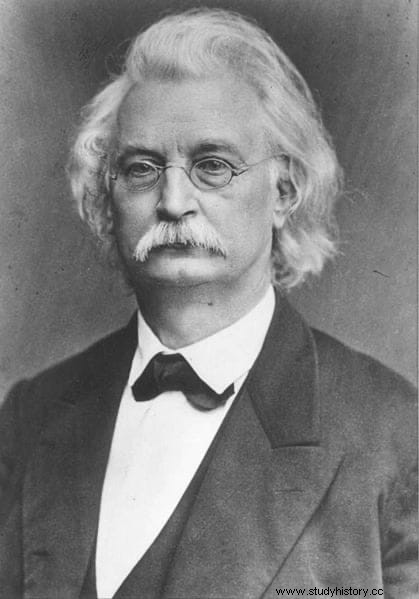
The name of this inventory is due to its creator, Karl Richard Lepsius, a Prussian archaeologist born in 1810 who is considered the father of Egyptology as a scientific discipline. Although he had studied classical archeology at several German universities (Leipzig, Göttingen and Berlin), obtaining a doctorate in 1833 with his thesis De tabulis Eugubinis , Lepsius was an enthusiastic follower of Champollion's studies on hieroglyphics to the point of traveling to Paris to see the Louvre funds up close. In fact, he made a tournée throughout Europe analyzing the Egyptian pieces that were kept in various museums.
In 1837 he published his own work on the subject, an expansion of Champollion's work but contradicting it on some points, such as the written representation of vowels. It was also he who, in 1842, translated a set of funerary and magical texts from the Ptolemaic era which he later published under the title Das Todtenbuch der Ägypter (The Book of the Death of the Egyptians). This title has lasted until today synthesized as the Egyptian Book of the Dead .
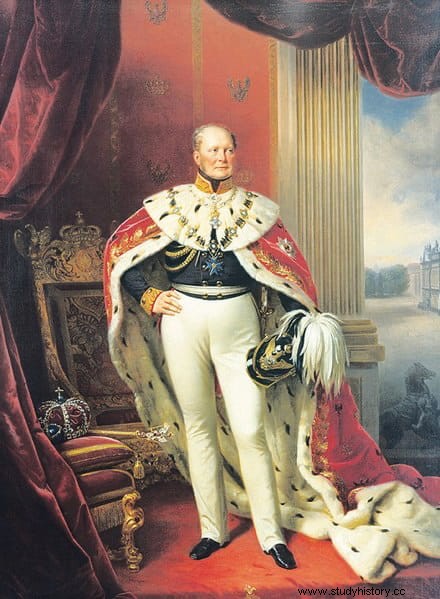
That curriculum opened the doors for him to lead an expedition to Egypt and Nubia that illustrious scholars such as Alexander von Humboldt and Robert Wilhelm Bunsen urged Frederick William IV to sponsor, following the example of the Franco-Tuscan expedition led by Champollion himself and directed by Ippolito Rosellini, with whom Lepsius exchanged correspondence. The goal was to explore and record remains of the ancient Egyptian civilization, bringing together an important collection for the Ägyptisches Museum in Berlin; Of its nearly fifteen thousand pieces, a good part would be obtained by him.
The journey began in 1842 and the itinerary covered all the places where there was monumental heritage of the pharaohs:Giza, Abusir, Sakkara, Dashur, Luxor, Karnak, even Nubia. For more than three years, Lepsius took the opportunity to study the local languages and excavate in places like Beni Hassan and Fayún; in the latter he brought to light the famous Labyrinth, a funerary complex cited by Greek and Roman authors such as Manetho, Diodorus Siculus, Strabo, Pliny the Elder and Pomponio Mela.
The Labyrinth consisted of hidden tunnels, chambers, chapels and crypts, all surrounded by a perimeter wall measuring three hundred and eighty-five meters by one hundred and fifty-eight meters, at the north end of which was the pyramid of Amenemhat III, a pharaoh of the Middle Kingdom (of the XII dynasty specifically); he was the son of Sesostris III and provided Egypt with a period of economic prosperity. Probably that half-crumbling pyramid was the one that aroused in Lepsius a special interest in the subject. In any case, he continued to excavate at more sites such as Qurna, Sinai and Tanis.
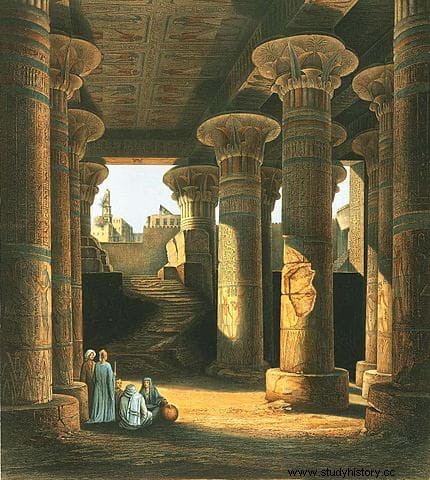
At that time, a suitable excavation technique had not yet been developed, since it is considered that the first to do so was the Englishman William Matthew Flinders Petrie (who, by the way, also later worked on the Labyrinth), so Lepsius resorted to methods. that are considered unacceptable today, such as using dynamite to dislodge heavy parts. The fact is that he managed to get hold of a good collection and return to Europe in 1846, following a somewhat exotic route through Beirut, Damascus, Baalbek and Istanbul.
That year must have left him with a double and unforgettable memory. On the one hand, he married Elisabeth Klein, with whom he had six children. Some of them became prestigious professionals in his profession:Richard, geologist; Griesheim, chemist; Reinhold, artist; and Johannes, a theologian who would also follow his father's tradition becoming an accomplished orientalist.
On the other hand, he was appointed professor at the University of Berlin and he began to work on the corresponding book with the results of his expedition. He titled it Denkmäler aus Äegypten und Äethiopien (Monuments of Egypt and Ethiopia) and was published between 1849 and 1858 reaching a dozen volumes, five of which were text and the others were illustrations (drawings, maps, plans, hieroglyphic reproductions...); many made by himself, since he had also studied engraving and lithography. In that work he reported the discovery of sixty-seven pyramids and one hundred and thirty other tombs, which were numbered in Roman characters in geographical order, from Lower Egypt to Upper Egypt.
The relationship began with Abu Roash (eight kilometers north of Giza); there, along with two others, was the pyramid of Djedefra (son of Cheops), the northernmost and already demolished since ancient times, probably by the Romans when they used it as a quarry. The list ended in Hawara, in Fayún, where the aforementioned pyramid of Amenemhat III was located. Between both places were those located in Giza (not only the big three but six other subsidiaries), Zawyet el-Aryan (two), Abu Gurab (one), Abusir (thirteen pyramids), Sakkara (apart from the stepped one there are seventeen more) , Dashur (thirteen), El Lisht (five), Meidum (one) and El Lahun (one).
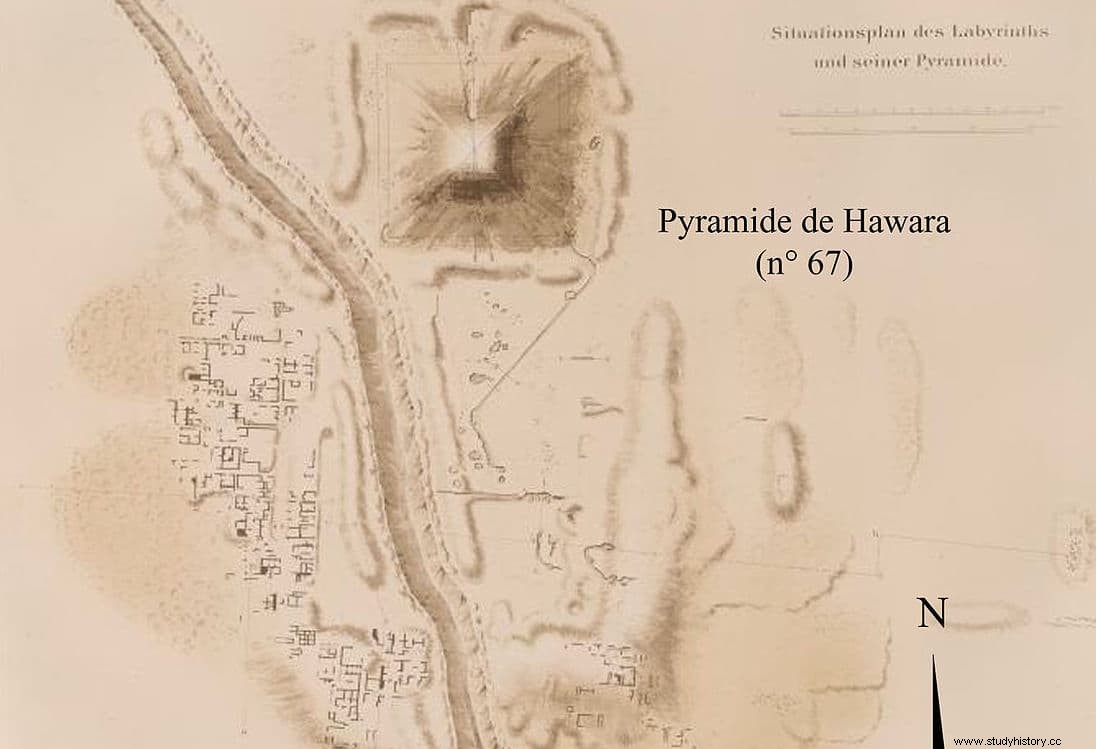
All were framed between the III (2686-2613 BC) and the XIII dynasties (1800-1650 BC). However, the list is not valid today because its author made some mistakes in identifying what were actually mastabas or different monumental structures as pyramid remains. Some confusions that lead to the fact that, of the total reviewed, more than twenty should not appear.
Now, we are talking about the always difficult beginnings of a science and the effort of that Prussian pioneer must be valued in that context; was the first attempt to make a systematic classification and, in fact, his numbering method is still used for those he cataloged well, to the point that in 2008 the famous Egyptian archaeologist and Minister of Antiquities Zahi Hawass rediscovered the platform of a review by Lepsius, who had disappeared by being covered by a dune.
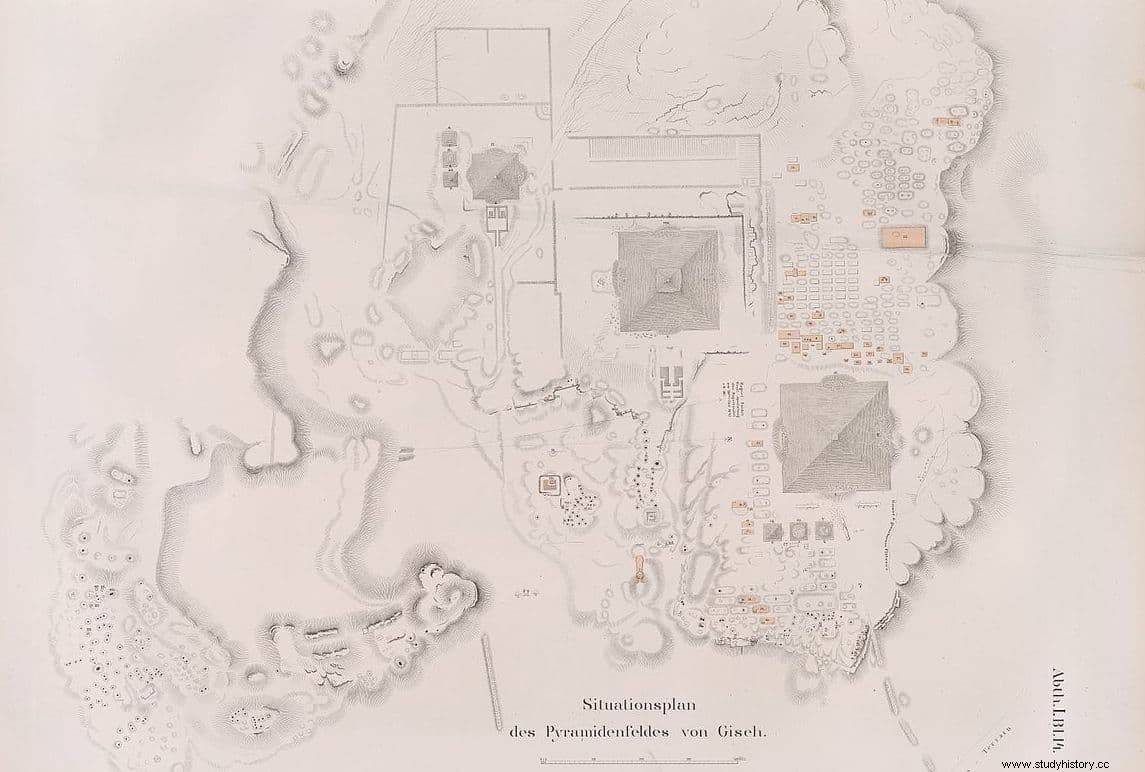
Likewise, his prestige is based on the fact that in 1855 he was appointed co-director of the aforementioned Berlin museum, to which he added the presidency of the German Archaeological Institute in Rome and the direction of the Royal Library of Berlin. He also founded a journal specializing in Egyptology, Zeitschrift für ägyptische Sprache und Altertumskunde , which is still in print today.
Lepsius passed away in 1884 but before that he returned to Egypt twice. The first, in 1866, focused on exploring the Nile delta area and excavating in Tanis he found the so-called Decree of Canopus , a stone stela from the time of Ptolemy III (dated to 237 BC) with calendrical information that, being written in Greek (uncial) and Egyptian (hieroglyphic and demotic), has been considered a second Rosetta Stone. The second was three years later on the occasion of the inauguration of the Suez Canal.
